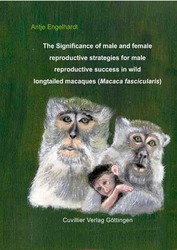| Areas | |
|---|---|
| Serie de libros (96) |
1379
|
| Nachhaltigkeit |
3
|
| Gesundheitswesen |
1
|
| Letra |
2367
|
| Ciencias Naturales |
5407
|
| Matemática | 229 |
| Informática | 319 |
| Física | 980 |
| Química | 1364 |
| Geociencias | 131 |
| Medicina humana | 243 |
| Estomatología | 10 |
| Veterinaria | 108 |
| Farmacia | 147 |
| Biología | 835 |
| Bioquímica, biología molecular, tecnología genética | 121 |
| Biofísica | 25 |
| Nutrición | 45 |
| Agricultura | 1004 |
| Silvicultura | 201 |
| Horticultura | 20 |
| Ecología y conservación de la tierra | 148 |
| Ciencias Ingeniería |
1793
|
| General |
98
|
|
Leitlinien Unfallchirurgie
5. Auflage bestellen |
|
Erweiterte Suche
The significance of male and female reproductive strategies for male reproductive success in wild longtailed macaques (Macaca fascicularis) (Tienda española)
Antje Engelhardt (Autor)Previo
Indice, Datei (43 KB)
Prologo, Datei (47 KB)
Lectura de prueba, Datei (58 KB)
The theory of sexual selection is nowadays commonly invoked to explain primate behaviour and evolution, although details of the proximate mechanisms involved remain poorly understood. Darwin already noted that females are apt to be the choosy sex and males the competitive sex due to differences in offspring investment. Although Fisher’s (1930) ‘runaway model’ and Zahavi’s (1975) ‘handicap principle’ strongly supported the idea of sexual selection for female mate preference, primatologists have for a long time seen female primates as the ‘passive’ sex, and males as actively determining reproductive events. Just recently, the importance of female reproductive strategies has become increasingly recognized, but still, little is known about the adaptive value of female reproductive strategies and their interaction with male reproductive strategies (Chism & Rogers 1997; Janson 1984; Small 1989; Taub 1980; Vasey 1998; Small 1989; Sterck et al. 1997). Sexual selection acts differently on males and females as females, especially in mammals, allocate a great proportion of their lifetime to parental effort through pregnancy and lactation, which limits the number of offspring a female mammal can produce in her lifetime. Males, on the other hand, produce lots of small, ‘cheap’ microgametes, predisposing them to maximize the number of successful matings. Thus, while males should compete for access to fertile females, females should ensure a high reproductive rate and survival of their offspring and, therefore, should be choosy in with whome they mate (Darwin 1871; Trivers 1972). As a consequence, reproductive strategies of the genders may even counteract each other and lead to inter-sexual conflict over reproduction (e.g. Trivers 1972; Smuts & Smuts 1993; Clutton-Brock & Parker 1995; Gowaty 1996; Nunn & van Schaik 2000).
| ISBN-10 (Impresion) | 3865371701 |
| ISBN-13 (Impresion) | 9783865371706 |
| ISBN-13 (E-Book) | 9783736911703 |
| Idioma | Alemán |
| Numero de paginas | 288 |
| Edicion | 1 |
| Volumen | 0 |
| Lugar de publicacion | Göttingen |
| Lugar de la disertacion | Göttingen |
| Fecha de publicacion | 20.09.2004 |
| Clasificacion simple | Tesis doctoral |
| Area |
Medicina humana
Biología |








